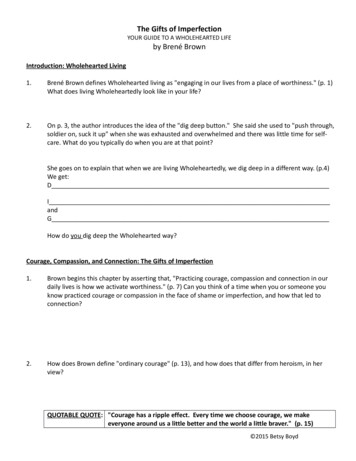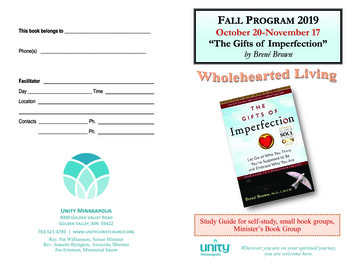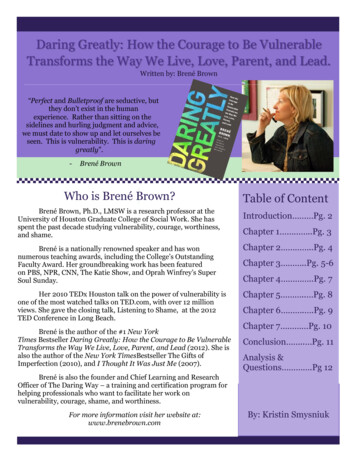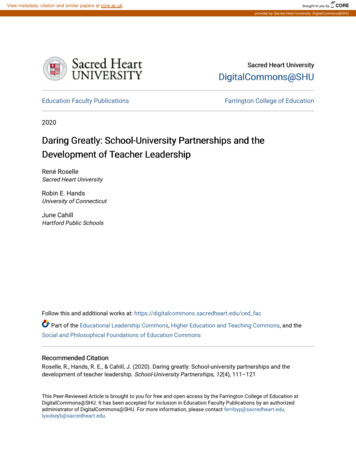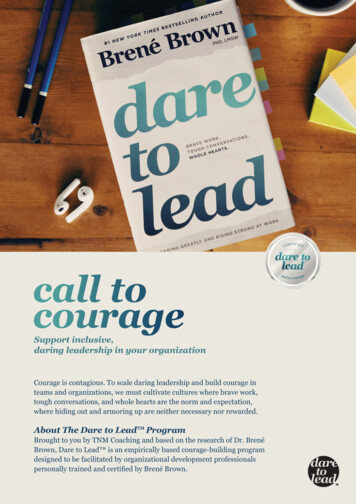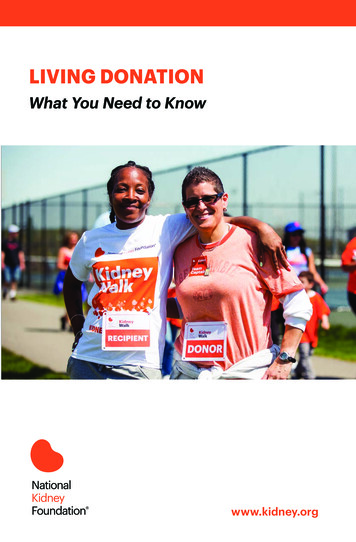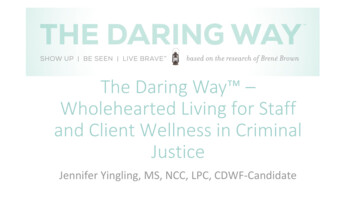
Transcription
The Daring Way ️ –Wholehearted Living for Staffand Client Wellness in CriminalJusticeJennifer Yingling, MS, NCC, LPC, CDWF-Candidate
I AMJENNI
Disclaimer Description of presentation: Researcher and author Brené Brown’swork has uncovered that we are all affected by shame andvulnerability, despite what we might think or want to believe. Thisworkshop will explain exactly what wholehearted living is, how tostrive toward it personally, and how it can impact the individuals weserve. Attendance at this presentation does NOT mean that you are able tofacilitate this work with others. Any copyrighted forms that are provided cannot be used with others.
Objectives 1. Understand the concepts of shame, guilt, trust, and empathy. 2. Describe what it means to “Show Up, Be Seen, Live Brave ️” 3. Determine ways to incorporate these concepts into yourprofessional life.
Introduction
Clarity of Values
Vulnerability is “Sharing an unpopular opinion” “Asking for help” “Helping my thirty-seven-year-old wife with Stage 4 breast cancermake decisions about her will” “Starting my own business” “Calling a friend whose child just died” “The first date after my divorce” “Getting promoted and not knowing if I’m going to succeed” “Asking for forgiveness” Sharing something you createdBrown, B. (2012). Daring greatly: How the courage to be vulnerable transforms the way we live,love, parent, and lead (pp. 35-37). New York, NY: Gotham Books.
Vulnerabilityis “Vulnerabilitysounds liketruth and feelslike courage.”Brown, B. (2012). Daring greatly: How the courage to be vulnerabletransforms the way we live, love, parent, and lead (p. 37). New York, NY:Gotham Books.
Vulnerability Myths Weakness Opt out Oversharing I can go it alone
Marble Jar - Trust
Shame versus GuiltShame “I am bad.” Self-focused An assault on who I amGuilt “I did something bad.” Behavior focused I’ve done something thatdoesn’t align with my values
SHAME Fear of disconnection. Three truths:1. We all have it.2. No one likes to talk about it.3. The less we talk about it the more control it has over our lives. Correlated with addiction, violence, aggression, depression, eating disorders, suicide, &bullying. 12 Shame Categories Shame resilience
Shame and Men “Shame is Failure. At work. On the football field. In your marriage. In bed.With money. With your children. It doesn’t matter —shame is failure.” “Shame is being wrong. Not doing it wrong, but being wrong.” “Shame is a sense of being defective.” “Shame happens when people think you’re soft. It’s degrading andshaming to be seen as anything but tough.” “Revealing any weakness is shaming. Basically, shame is weakness.” “Showing fear is shameful.” “Shame is being seen as “the guy you can shove up against the lockers.””Brown, B. (2012). Daring greatly: How the courage to be vulnerable transforms the way we live, love, parent,and lead (pp.91-92). New York, NY: Gotham Books.
Shame and Women “Look perfect. Do perfect. Be perfect. Anything less than that is shaming.” “Being judged by other mothers.” Being exposed—the flawed parts of yourself that you want to hide fromeveryone are revealed.” Even though everyone knows that there’s no way to do it all, everyone stillexpects it. Shame is when you can’t pull off looking like it’s under control.” “Shame is never enough.” “No seat at the cool table. The pretty girls are laughing.”Brown, B. (2012). Daring greatly: How the courage to be vulnerable transforms the way we live, love,parent, and lead (pp. 85-86). New York, NY: Gotham Books.
The ArmoryForeboding JoyGratitude “Paradoxical dread that clampsdown on momentaryjoyfulness.” p. 117 Joy comes in ordinary moments p. “When we lose the ability orwillingness to be vulnerable, joybecomes something weapproach with deepforeboding.” p. 118125 “Don’t take what you have forgranted Don’t apologize for whatyou have When you honor whatyou have, you’re honoring whatI’ve lost.” p. 125 “Every time we allow ourselves tolean into joy and give in to thosemoments, we build resilience andwe cultivate hope.” p. 126
The ArmoryPerfectionismAppreciating the beauty of cracks “Believing that doing everythingperfectly means you’ll never feelshame.” p. 117 Striving for excellence isinternally driven whileperfectionism is externallydriven. Self-Kindness Common Humanity Mindfulness
The ArmoryNumbing “The embrace of whateverdeadens the pain of discomfortand pain.” p. 117 Food, sugar, drugs, alcohol (maybeeven the few glasses to take theedge off), Tylenol PM, prescriptionpills, sex, internet, Facebook,Fantasy football, work, gossip, etc. Cannot selectively numbSetting boundaries, finding truecomfort, and cultivating spirit “Learning how to actually feeltheir feelings.” p. 142 “Staying mindful about numbingbehaviors.” p. 142 “Learning how to lean into thediscomfort of hard emotions.” p.142
The ArmoryViking or Victim Victim: “a sucker or a loserwho’s always being takenadvantage of and can’t holdyour own” p. 152 Viking: “someone who sees thethreat of being victimized as aconstant, so you stay in control,you dominate, you exert powerover things, and you never showvulnerability.” p. 152Redefining success, reintegratingvulnerability, and seeking support Surviving or winning, in theabsence of combat or trauma, isnot truly living. Examining shame triggers toreintegrate vulnerability Reaching out and connecting
The ArmoryFloodlighting(Letting it All Hang Out) When we share vulnerability,especially shame stories, withsomeone with whom there is noconnectivity, their emotional (andsometimes physical) response isoften to wince, as if we have shonea floodlight in their eyes. P. 160 Results in disconnection, distrust,and disengagement (p. 159)Clarifying intentions, settingboundaries, and cultivating connection Why am I sharing this? P. 162 Do I still have unmet needs that I amlooking to get met? What emotions am I experiencing? P. 162 Am I in a place that I am ready to talkabout this? With whom? Will sharing this really build connection? Do my intentions align with my values? P.162 Is there an outcome, response, or lack of aresponse that will hurt my feelings? P. 162
The ArmoryThe Smash and Grab(Letting it All Hang Out) Using oversharing as amanipulation tool. “The smash and grab used asvulnerability armor is aboutsmashing through people’ssocial boundaries with intimateinformation, then grabbingwhatever attention and energyyou can get your hands on.” p. 163Questioning intentions Same questions as withfloodlighting. “Am I trying to reach, hurt, orconnect with someonespecifically, and is this the rightway to do it?” p. 164
The ArmorySerpentining Dodging vulnerabilityBeing present, paying attention,moving forward Breathe Humor Move on
The ArmoryCynicism, criticism, cool, and cruelty “Cynicism, criticism, cruelty, andcool are even better thanarmor—they can be fashionedinto weapons that not only keepvulnerability at a distance butalso can inflict injury on thepeople who are beingvulnerable and making usuncomfortable.” p. 167Tightrope walking, practicing shameresilience, and reality checking “When we stop caring what peoplethink, we lose connection Whenwe become defined by whatpeople think, we lose willingness tobe vulnerable.” p. 169 Understand what triggered it,what it means about sense of selfworth, talking to someone youtrust, and asking for what youneed. If you aren’t in the arena, youropinion doesn’t count. 1 x 1 inch square
EMPATHY
Shame Resilience1.2.3.4.Recognizing shame and understanding its triggersPracticing critical awarenessReaching outSpeaking shame
Applications t/ “Loosening the shackles of judgment, criticism and fear, and replacing themwith the experience of vulnerability, community and freedom, haveimmediate impacts on the women, many of whom have never had theopportunity to express themselves in a safe environment. And notsurprisingly, it has an immediate impact on the prison environment.” mask/ “One Sing Sing prisoner in RTA’s production of Of Mice and Men told us thathe cried for the first time in ten years after the performance. Now, that’sgetting in touch with your humanity.” “Theater creates a very effective way to [have empathy] How can youcommit a crime when you can feel the pain it will cause someone?”
Applications Gangi, A. (2015, September 15). Why it’s OK to be empathetic towardinmates. Retrieved February 24, 2018, towardinmates/ “I’ve used what I’ve learned about empathy to understand what ishappening to my wife with her health problems and to work to repairour relationship.” “I used what I learned to talk to my son about a fight he got into inschool.”
WHO I AM TODAY
Jennifer Yingling, MS, NCC, LPCjenniferyingling.lpc@gmail.com
Cynicism, criticism, cool, and cruelty "ynicism, criticism, cruelty, and cool are even better than armor—they can be fashioned into weapons that not only keep vulnerability at a distance but also can inflict injury on the people who are being vulnerable and making us uncomfortable." p. 167 Tightrope walking, practicing shame

